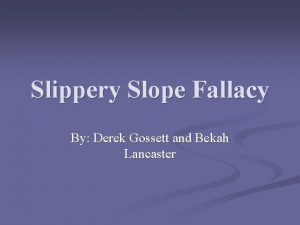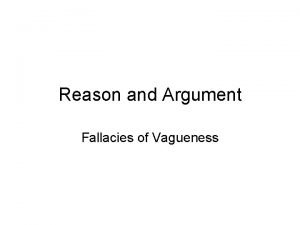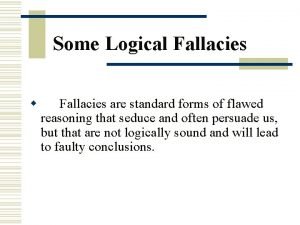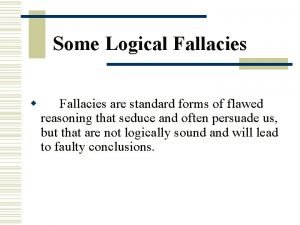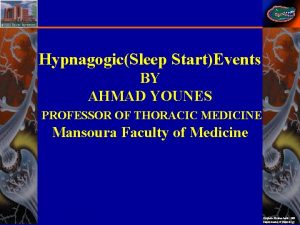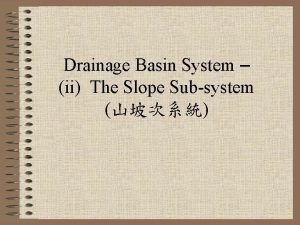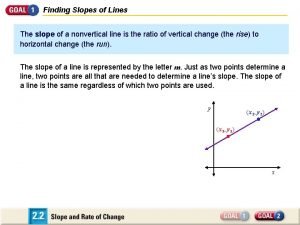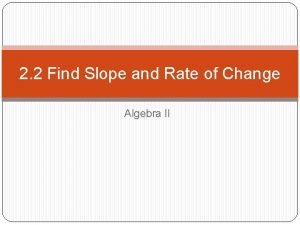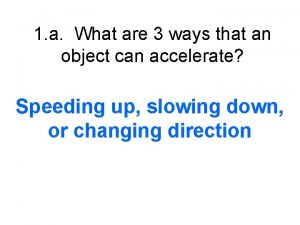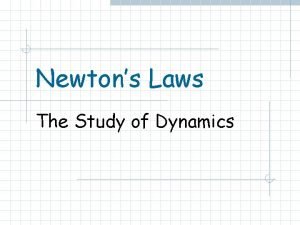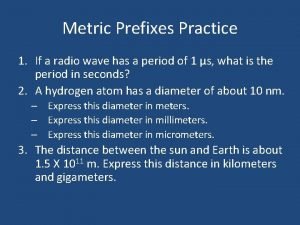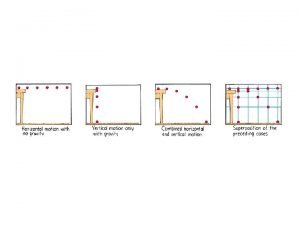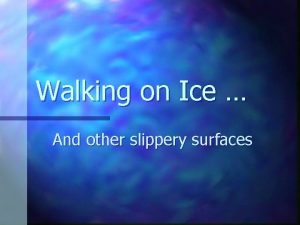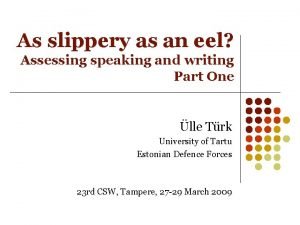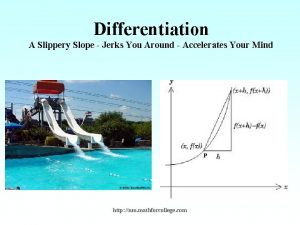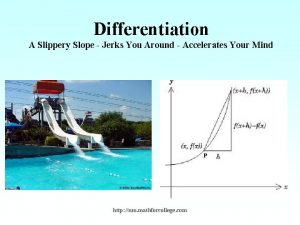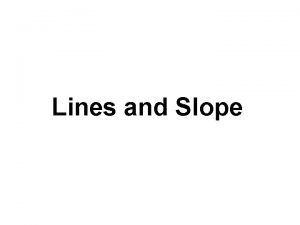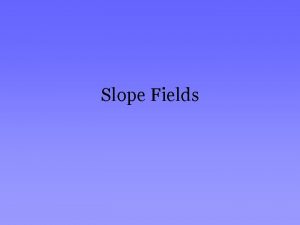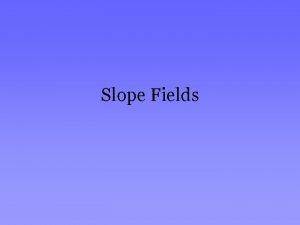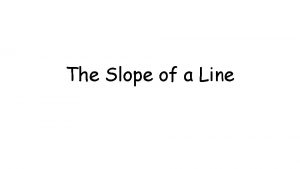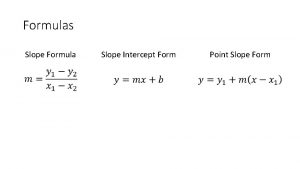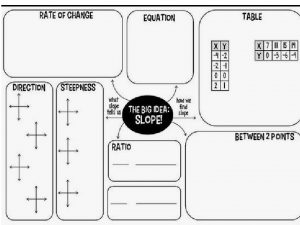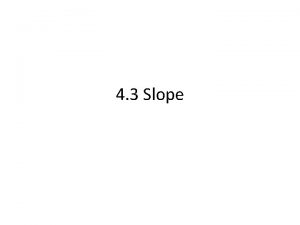Differentiation A Slippery Slope Jerks You Around Accelerates





























- Slides: 29

Differentiation A Slippery Slope - Jerks You Around - Accelerates Your Mind http: //nm. mathforcollege. com

Oil Spill Time (s ) 0 0. 5 1. 0 1. 5 2. 0 2. 5 3. 0 3. 5 4. 0 4. 5 5. 0 Radius(m ) 0 0. 236 0. 667 1. 225 1. 886 2. 635 3. 464 4. 365 5. 333 6. 364 7. 454 http: //nm. mathforcollege. com

Acceleration of a rocket http: //nm. mathforcollege. com

2. 01 BACKGROUND http: //nm. mathforcollege. com

To find location from velocity vs time data of the body, the mathematical procedure used is A. Differentiation B. Integration http: //nm. mathforcollege. com

The definition of the exact derivative of the function f (x) is A. B. C. D. http: //nm. mathforcollege. com

The exact derivative of f (x)=x 3 at x=5 is most nearly A. B. C. D. 25. 00 75. 00 106. 25 125. 00 http: //nm. mathforcollege. com

Given y=5 e 3 x + sinx, dy/dx is 1. 2. 3. 4. 5 e 3 x + cos(x) 15 e 3 x – cos(x) 2. 666 e 3 x – cos(x) http: //nm. mathforcollege. com

Given y=sin(2 x), dy/dx at x=3 A. B. C. D. 0. 9600 0. 9945 1. 920 1. 989 http: //nm. mathforcollege. com

END http: //nm. mathforcollege. com

02. 02 CONTINUOUS FUNCTIONS http: //nm. mathforcollege. com

Given f (x)=x 2, using forwarded divided difference scheme and step size of 0. 2, the value of f ′ (6) most nearly is A. 11. 8 B. 12. 0 C. 12. 2 D. 36. 0 http: //nm. mathforcollege. com

Using forwarded divided difference with a step size of 0. 2, the derivative of f(x)=5 e 2. 3 x at x=1. 25 is A. B. C. D. 258. 8 163. 4 211. 1 203. 8 http: //nm. mathforcollege. com

The order of accuracy of the forwarded divided difference approximation is 1) O(h) 2) O(h 2) 3) O(h 3) http: //nm. mathforcollege. com

The highest order of polynomial for which the forward divided difference gives the exact answer for its first derivative at any point is A. B. C. D. 0 1 2 3 http: //nm. mathforcollege. com 10

Using forward divided difference, the true error in the calculation of a derivative of a function is 32. 0 for a step size of 0. 4. If the step size is reduced to 0. 1, the true error will be approximately A. B. C. D. 2. 0 4. 0 8. 0 16. 0 http: //nm. mathforcollege. com 10

The highest order of polynomial for which the central divided difference gives the exact answer for its first derivative at any point is A. B. C. D. 0 1 2 3 http: //nm. mathforcollege. com 10

The order of accuracy of the central divided difference approximation is 1) O(h) 2) O(h 2) 3) O(h 3) http: //nm. mathforcollege. com

Using central divided difference, the true error in the calculation of a derivative of a function is 32. 0 for a step size of 0. 4. If the step size is reduced to 0. 1, the true error will be approximately A. B. C. D. 2. 0 4. 0 8. 0 16. 0 http: //nm. mathforcollege. com 10

A function is differentiable and all its derivatives are also differentiable between 0 and 10. Given f (2 )=7, f ′(2)=12 and all other derivatives of f(x) at x=2 are zero, the value of f (5) is 1. 2. 3. 4. 36 43 60 Cannot be found http: //nm. mathforcollege. com

END http: //nm. mathforcollege. com

02. 03 DISCRETE FUNCTIONS http: //nm. mathforcollege. com

The velocity vs. time is given below. The best estimate of acceleration at t =1. 5 s in m/s 2 is t (s) 0 0. 5 1. 1 1. 5 1. 8 v (m/s) 0 213 223 275 300 A. B. C. D. 83. 33 128. 33 173. 33 183. 33 http: //nm. mathforcollege. com

The velocity vs. time is given below. The best estimate of acceleration at t =1. 5 s in m/s 2 is t (s) 0 0. 5 1. 2 1. 5 1. 8 v (m/s) 0 213 223 275 300 A. B. C. D. 83. 33 128. 33 173. 33 183. 33 http: //nm. mathforcollege. com

Allowed to use only a second order polynomial to approximate velocity, the data points you would choose to find the velocity of the rocket at t=1. 1 s are t (s) 0 0. 5 1. 2 1. 5 1. 8 v (m/s) 0 213 223 275 300 A. B. C. D. t=0, 0. 5, 1. 2 t=0. 5, 1. 2, 1. 3 t=1. 2, 1. 3, 1. 4 t=0, 1. 2, 1. 4 http: //nm. mathforcollege. com

The velocity vs time is given below. The values at t=1. 2, 1. 5 and 1. 8 are interpolated to a 2 nd order polynomial. The best estimate of acceleration at t=1. 5 in m/s 2 is t(s) 0 v(m/s) 0 A. B. C. D. 0. 5 213 1. 2 223 1. 5 275 1. 8 300 83. 33 128. 33 173. 33 275. 00 http: //nm. mathforcollege. com

In a circuit with an inductor of inductance L, a resistor with resistance R, and a variable voltage source E(t), Time, t (secs) 1. 00 1. 01 1. 03 1. 1 Current, i (amperes) 3. 10 3. 12 3. 18 3. 24 If L=0. 98 henries and R=0. 142 ohms, find E(1. 00) with most accuracy and choosing amongst FDD, BDD or CDD. A. B. C. D. http: //nm. mathforcollege. com

END http: //nm. mathforcollege. com

http: //nm. mathforcollege. com
 Bekah definition
Bekah definition Abigail's promise fallacy meaning
Abigail's promise fallacy meaning Vagueness fallacy
Vagueness fallacy Faulty analogy definition
Faulty analogy definition Slippery fallacy
Slippery fallacy Kabiri zoetermeer
Kabiri zoetermeer Slippery slope
Slippery slope Slippery slope fallacy examples
Slippery slope fallacy examples Jerks dodsonov zakon
Jerks dodsonov zakon Jerks dodsonov zakon
Jerks dodsonov zakon Lovable fool
Lovable fool Intensified hypnic jerks
Intensified hypnic jerks The difference between slope decline and slope retreat
The difference between slope decline and slope retreat Point-slope form definition geometry
Point-slope form definition geometry Slope review classifying slope
Slope review classifying slope Slope review classifying slope
Slope review classifying slope What goes around comes around examples
What goes around comes around examples Goes around comes around meaning
Goes around comes around meaning A car of mass 1000 kg accelerates
A car of mass 1000 kg accelerates Chapter 11 motion section 2 acceleration answer key
Chapter 11 motion section 2 acceleration answer key Describe how a baseball player accelerates
Describe how a baseball player accelerates Normal force equation
Normal force equation Marissa's car accelerates uniformly
Marissa's car accelerates uniformly A teacher applies a force to a wall and becomes exhausted.
A teacher applies a force to a wall and becomes exhausted. Find the average acceleration of a northbound subway
Find the average acceleration of a northbound subway Describing and measuring motion worksheet
Describing and measuring motion worksheet A car of mass 1400kg pulling a trailer of mass 400 kg
A car of mass 1400kg pulling a trailer of mass 400 kg Walking on slippery surfaces
Walking on slippery surfaces Slippery stuff walgreens
Slippery stuff walgreens As slippery as a
As slippery as a
